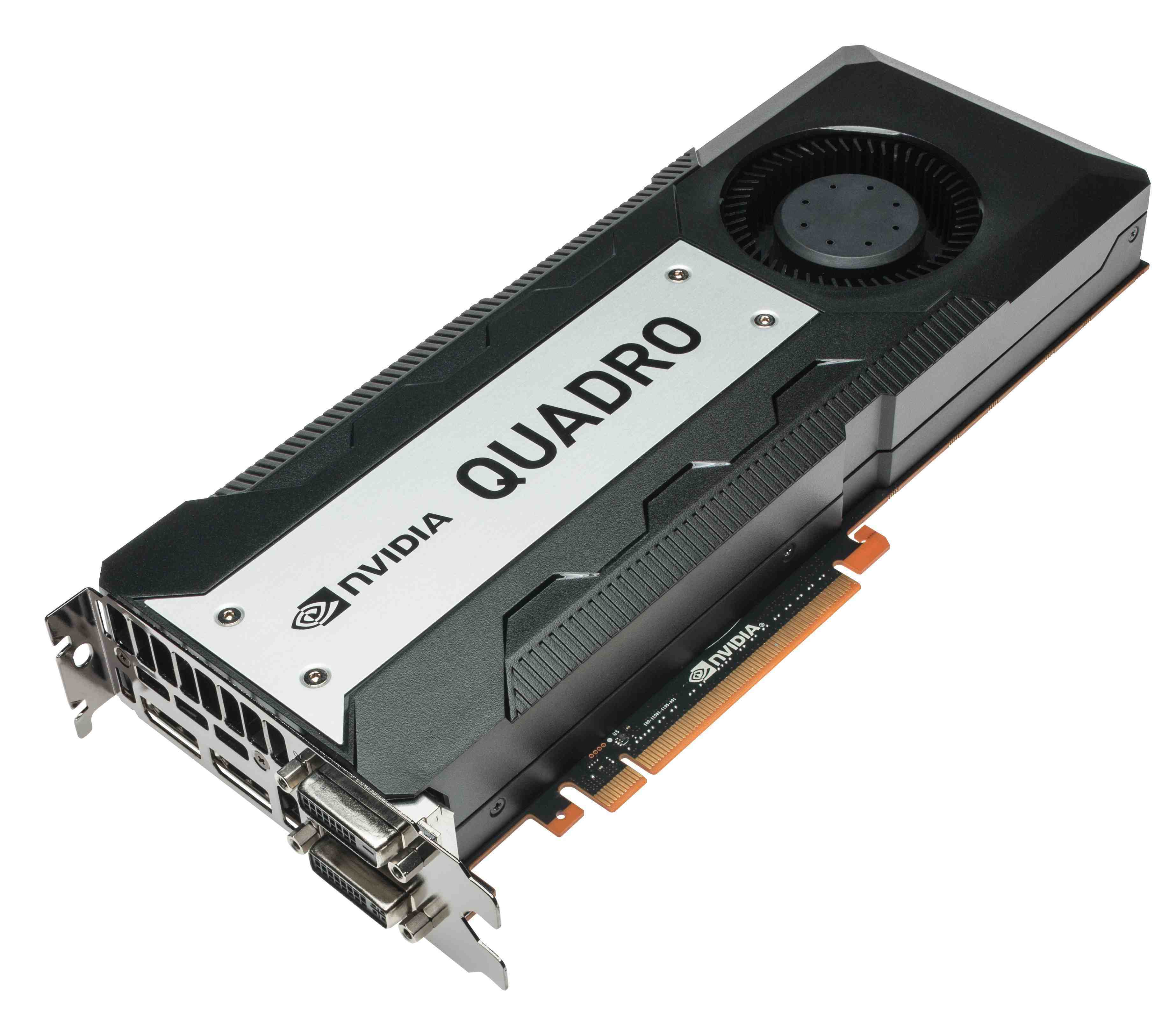Nvidia Announces Quadro K6000 Workstation GPU
Today at SIGGRAPH 2013 in Anaheim, CA, Nvidia announced the new 'top card' for its Quadro line of workstation graphics cards, the Quadro K6000.
Nvidia is today using SIGGRAPH 2013 as a launchpad for a new 'top card' in its Quadro line of workstation graphics cards. As the new flagship of Nvidia's professional graphics line, the Quadro K6000 introduces unrivaled power for a workstation GPU as well as 12 GB of memory, the largest amount of GPU memory yet available. Check the specs below:
| SPECIFICATIONS | |
|---|---|
| GPU | GK110 |
| GPU Memory | 12 GB DDR5 |
| Memory Interface | 384-bit |
| Memory Bandwidth | 288 GB/s |
| CUDA Cores | 2880 |
| Single-precision Floating Point Performance | 5.2 TFLOPs |
| System Interface | PCI Express 3.0 x16 |
| Max Power Consumption | 225W |
| Thermal Solution | Ultra-quiet active fansink |
| Form Factor | 4.4”H × 10.5”L, Dual Slot, Full Height |
| Display Connectors | DVI-I DL + DVI-D DL + 2x DP1.2 + Stereo |
| Max Simultaneous Displays | 4 |
| Max DP 1.2 Resolution | 3840 × 2160 at 60 Hz |
| Max DVI DL Resolution | 2560 × 1600 at 60 Hz |
| Max DVI SL Resolution | 1920 × 1200 at 60 Hz |
| Max VGA Resolution | 2048 × 1536 at 85 Hz |
| Graphics APIs | Shader Model 5.0, OpenGL 4.3, DirectX 11 |
| Compute APIs | CUDA, DirectCompute, OpenCL |
Pretty impressive specsheet and the 2880 CUDA cores and 12 GB of GPU memory ensure it's not just the 'Quadro version of the Titan.' Nvidia is going to great lengths to present the advantage of the 12 GB of memory on the card in three key markets: animation and visual effects, automotive and product design, and energy exploration.
First, the company gave a prototype card to the boys (and girls) at Pixar. You can see what they had to say about it above. Considering Pixar doesn't normally endorse any kind of products, this is high praise. The particular interest in this card for the entertainment market is that they can use higher levels of detail than they previously could and still maintain interactivity.
Then Nvidia gave one to the design center at Nissan North America. The Pathfinder above is forty million polygons. Normally, when the design center receives a car design from engineering to do visualizations, they get a NURBS-based CAD model which they first convert into polygons and then spend hours (more than likely days) reducing the resolution of in order for the model to be useable. Things like reducing the overall polygon count without losing the fine detail, greatly reducing the complexity of the interior when doing visualizations of the exterior (and vice versa), greatly simplifying the chassis parts, etc. With the Quadro K6000, they were able to take the above model , import it and do elementary cleanup, and then surface it for rendering. This is instead of spending large amounts of time just making the model lightweight enough to manipulate in RTT Deltagen, Nissan's application of choice.
Lastly, one was given to Apache Corporation. Apache uses Terraspark's InsightEarth for oil and gas exploration. This work involves huge datasets - hundreds of gigabytes - and they are using GPUs to process the data. The larger GPU memory size means they can load much larger segments of their dataset onto the GPU, thiu greatly speeding up their work.
Nvidia expects the Quadro K6000 to be available this fall throughout its normal professional graphics distribution channels. Expected price is unavailable at this time, but Nvidia expects top announce its price as it gets closer to its ship date.
Get Tom's Hardware's best news and in-depth reviews, straight to your inbox.
-
Giovanni-L For clients this size (Pixar and Nissan), the price must be coherent so they too find it "relatively expensive". These guys must have rigs armed with triple SLIs of these beasts of a card...Reply
Preeeeety far away from any mere mortal and us "herculean small heroes" of gaming.
*Herculean small heroes? Yes. We are the toughest around in the playground, but the big guys are in the principal's office. -
nord_musician ^ They don't use SLI. Yes, they do have a couple of cards installed but they dont have to do SLI, specially if they use OPENCL, CUDA. Heck does even Quadro supports SLI? :pReply -
giovanni86 I believe the cards have a form of sli, if u go check out the tesla cards and quadro's you can notice they do have a SLI connector on them. But since i don't own or have had any workstation card in a desktop i wouldn't know for sure. I can only imagine if this was a GPU for gaming, 12GB's! I still remember when 256MB's or even 64MB's was a big deal.Reply -
kinggremlin Quadro's are SLI capable, but the workstation they are used in has to be certified for it for NVidia to guarantee proper operation.Reply
A TDP of 225W is mighty impressive when you consider that the Titan is rated at 250W. -
Blazer1985 Three way "sli" of 580-680-titans are quite common in average 3D studios. These are as always the best professional certified cards out there but cost way too much for what they offer (even with double precision performance cropped on the GTXs)Reply
However Gpgpu often perform better when not connected through sli cable :-) -
nord_musician Maybe the question is. Would it be any gains on non-gaming software if SLI is used on Quadro/Tesla cards?Reply -
renz496 Reply11213261 said:Quadro's are SLI capable, but the workstation they are used in has to be certified for it for NVidia to guarantee proper operation.
A TDP of 225W is mighty impressive when you consider that the Titan is rated at 250W.
Well pro cards like quadro often clocked much lower than their geforce counterpart for stability so it's not really suprising if quadro cards like K6000 consume much less.
So the yeild finally good enough for nvidia to start selling product based on fullly enabled GK110. -
dragonsqrrl Reply11213571 said:Three way "sli" of 580-680-titans are quite common in average 3D studios. These are as always the best professional certified cards out there but cost way too much for what they offer (even with double precision performance cropped on the GTXs)
However Gpgpu often perform better when not connected through sli cable :-)
You're essentially paying for the drivers, and the additional optimization and validation for a wide range of professional applications. Unless the "3D studios" you're referring to run games, I can't imagine why they would be running any sort of SLI setup in their workstations. None of the content creation or video editing software I'm familiar with can take advantage of SLI for viewport or output rendering acceleration.
And I don't think SLI plays much of a role in multi-GPU compute performance. I always thought SLI was meant specifically for rendering, pretty much exclusively in games. But Tesla cards also include SLI bridge support, so I'm not sure. As far as I know you don't need to be running two GPU's in SLI to achieve parallel scaling from the second GPU. -
dragonsqrrl Reply11214332 said:11213261 said:Quadro's are SLI capable, but the workstation they are used in has to be certified for it for NVidia to guarantee proper operation.
A TDP of 225W is mighty impressive when you consider that the Titan is rated at 250W.
Well pro cards like quadro often clocked much lower than their geforce counterpart for stability so it's not really suprising if quadro cards like K6000 consume much less.
The thing is the stock clock on the K6000 is estimated to be higher than any other GK110 based card, including the GTX780. In addition it uses a fully enabled 15 SMX GK110. It would be interesting to compare real world load power consumption between the Titan and K6000. If I had to guess the official TDP isn't telling the whole story on power consumption. One theory might be that the higher TDP on the Geforce cards allows for higher and more consistent boost-clocks and greater overclocking headroom, where as Quadro cards don't have a boost clock. It isn't unusual for a Titan to run consistently at or above 900MHz at load, despite the top boost clock of 876MHz in the specs.
In any case this card is going to be an absolute beast. 5.2 TFLOPS SP is very impressive, but 1.7 TFLOPS DP is just insane. It's been a long time since Nvidia launched a Quadro card with raw clocks and specs similar to its Geforce counterparts. They must be really confident in these top binned GK110's. -
bambiboom Gentlemen?,Reply
NVIDIA will sell far more of these - my wild guess is $4,650- than we mere mortals might expect, as the visual aids for the advancing realm of the Personal Supercomputer.
The recent increase in availability of of 4X and 8X CPU, 8 and 10 core CPU's (10-core Xeons are $3,500+) supporting up to 4TB of ECC RAM - that's a $35,000 story in itself- plus the important advances offered by PCIe coprocessing modules such as Tesla K20 and Intel Xeon Phi will bring> atmospheric, oceanic, astrohysical, chemical, metallurgical, and particle modeling, CGI feature film animation/ editing, gas, dynamic structural, thermal, mechanical, financial, resources exploration, and aerodynamic simulation to a new level of accessibility- well relatively.
The Titan supercomputer at Oak Ridge, currently the most powerful calculating machine in the World, is using massively parallel components of which the bulk of the fundamental components > AMD CPU's and the Tesla K20X coprocessors are a $97,000,000 configuration of multiples (18,600+ of each) of components found at newegg and amazon. That's the key to all this- string together many, semi-consumer level parts into a massive system > it's AI Modular Man! And the Quadro K6000 as an extreme performer will be one of the big picture windows to those events.
BambiBoom >
Quadro's > FX 4800, FX 580, FX 570, FX 550 (retired) > Aspirational > K4000
PS > And yes, the K6000 is guaranteed to be SLI- capable as are the Quadro 6000 and K5000 along with the Quadro FX 4800 (1.5 GB) and FX 5800 (4GB) of two generations ago.



